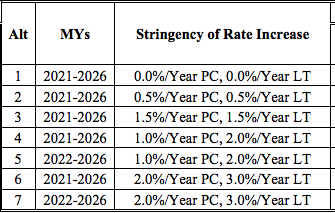On March 31, the National Highway Traffic Safety Administration (NHTSA) and the Environmental Protection Agency (EPA) released the final Safer Affordable Fuel-Efficient (SAFE) Vehicles Rule, which applies to passenger cars and light duty trucks. The rule lowers the stringency of corporate average fuel economy (CAFE) and carbon dioxide emissions standards to increases of 1.5 percent each year between 2021 and 2026, down from the required five percent annual increases in stringency of the standards issued in 2012.
Per the Energy Policy and Conservation Act of 1975, NHTSA is required to set fuel economy standards at the maximum feasible level for every model year. These can be amended by NHTSA as it deems appropriate, based on the agency’s assessment of technological feasibility, economic practicability, the effect of other motor vehicle standards of the Government on fuel economy, and U.S. energy conservation needs. The U.S. Court of Appeals for the Ninth Circuit stated that NHTSA has the discretion to determine how to balance statutory factors so long as the primary goal of the EPCA – energy conservation – is not undermined.
The Trump administration states that the SAFE Vehicles Rule reflects lower oil prices, increases in U.S. oil production, and growing consumer demand for larger vehicles today compared to 2012, when the current standards were released. The main intended outcomes of the rule as written – protecting the environment, improving safety, and boosting the economy – have been scrutinized since the draft SAFE Vehicles Rule was first proposed in 2018.
For the final rule, NHSA and EPA considered seven alternatives – from a complete freeze on passenger car (PC) and light truck (LT) fuel economy standards through 2030 (what the White House originally sought), through staggered annual increases up to 2.0 percent per year for cars and 3.0 percent per year for light trucks. They wound up choosing Option 3, steady 1.5 percent per year increases for both cars and light trucks.

The SAFE Rule will result in a projected average fuel economy of 40.4 miles per gallon for vehicles manufactured model year 2026, which the administration states will provide a “range of affordable, safe, and fuel-efficient vehicles” to consumers. This is in contrast to an updated MY 2025 CAFE equivalent of 49.7 mpg or a 54.5 mpg GHG-equivalent standard, depending on how you want to look at it, according to the Congressional Research Service (Table 1 here).
| Average of OEM’s CAFE and CO2 Estimated Proposed Requirements Under the Final SAFE Rule |
|
MY20 |
MY21 |
MY22 |
MY23 |
MY24 |
MY25 |
MY26 |
| Pass. Cars |
43.6 |
44.2 |
44.9 |
45.6 |
46.3 |
47.0 |
47.7 |
| Light Trucks |
31.1 |
31.6 |
32.1 |
32.6 |
33.1 |
33.6 |
34.1 |
| Average |
36.8 |
37.3 |
37.9 |
38.5 |
39.1 |
39.8 |
40.4 |
According to the Rule, vehicles will also still be subject to the Clean Air Act’s pollution standards. However, NHTSA and EPA’s own analysis of the SAFE Rule indicates that it would result in an increase of 874 million metric tons (MMT) of CO2 emissions. (For reference, a reduction of just one MMT is equivalent to 216,000 passenger cars not being driven for one year.)
With respect to safety, the administration’s analysis suggests that the new rule will result in 3,300 fewer fatalities, almost 400,000 fewer injuries, and over 1.8 million fewer vehicle damages. Their argument largely hinges on the idea that new vehicles have more safety features, like automatic breaking systems, and that easing fuel efficiency standards can make these cars more affordable and thus, more common. Researchers have indicated that there is no evidence to back NHTSA’s arguments about the safety claims in this rule.
The Trump administration further states that the SAFE Vehicles Rule will reduce vehicle prices, boost vehicle sales, and create millions of jobs, which could be especially significant in the current moment of economic uncertainty due to the COVID-19 outbreak. However, car sales have taken a huge hit in the first quarter of this year and others have projected that it will take time for the automobile supply chain to rebound.
The rule is also intended to create one set of standards, or “One National Program”, for auto manufacturers to follow, and in 2019 EPA announced its intention to withdraw the waiver it granted to California for the State’s greenhouse gas and zero emission vehicle programs of the Clean Air Act. The Clean Air Act currently allows California to set its own standards. California and 22 other states challenged the One National Program Rule in court, and the Complaint is currently under litigation. As that litigation plays out, automakers may actually face more uncertainty with the national auto market effectively split into two different standards.
As of April 1, five automakers (Volvo, BMW, Ford, Honda, and Volkswagen) have signed onto California’s voluntary agreement on fuel economy standards. The newest of these companies, Volvo, stated that California’s standards “better align” with the company’s goals. By contrast, General Motors, Fiat Chrysler, and Toyota backed the Trump Administration earlier in this rulemaking process.




